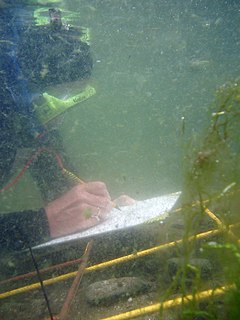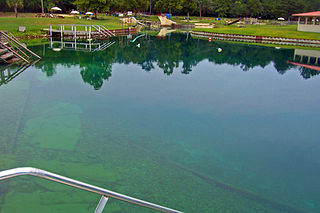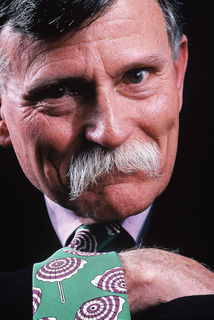
Underwater archaeology is archaeology practiced underwater. As with all other branches of archaeology, it evolved from its roots in pre-history and in the classical era to include sites from the historical and industrial eras. Its acceptance has been a relatively late development due to the difficulties of accessing and working underwater sites, and because the application of archaeology to underwater sites initially emerged from the skills and tools developed by shipwreck salvagers. As a result, underwater archaeology initially struggled to establish itself as bona fide archaeological research. The situation changed when universities began teaching the subject and when a theoretical and practical base for the sub-discipline was firmly established. Underwater archaeology now has a number of branches including, after it became broadly accepted in the late 1980s, maritime archaeology: the scientifically based study of past human life, behaviours and cultures and their activities in, on, around and (lately) under the sea, estuaries and rivers. This is most often effected using the physical remains found in, around or under salt or fresh water or buried beneath water-logged sediment. In recent years, the study of submerged WWII sites and of submerged aircraft in the form of underwater aviation archaeology have also emerged as bona fide activity.

Cave diving is underwater diving in water-filled caves. It may be done as an extreme sport, a way of exploring flooded caves for scientific investigation, or for the search for and recovery of divers lost as a result of one of these activities. The equipment used varies depending on the circumstances, and ranges from breath hold to surface supplied, but almost all cave diving is done using scuba equipment, often in specialised configurations with redundancies such as sidemount or backmounted twinset. Recreational cave diving is generally considered to be a type of technical diving due to the lack of a free surface during large parts of the dive, and often involves planned decompression stops.
Sheck Exley was an American cave diver. He is widely regarded as one of the pioneers of cave diving, and he wrote two major books on the subject: Basic Cave Diving: A Blueprint for Survival and Caverns Measureless to Man. On February 6, 1974, Exley became the first chairman of the Cave Diving Section of the National Speleological Society. During his career, he established many of the basic safety procedures used in cave and overhead diving today. Exley was also a pioneer of extreme deep scuba diving.

The Windover Archeological Site is a Middle Archaic archaeological site and National Historic Landmark in Brevard County near Titusville, Florida, USA, on the central east coast of the state. Windover is a muck pond where skeletal remains of 168 individuals were found buried in the peat at the bottom of the pond. The skeletons were well preserved because of the characteristics of peat. In addition, remarkably well-preserved brain tissue has been recovered from many skulls from the site. DNA from the brain tissue has been sequenced. The collection of human skeletal remains and artifacts recovered from Windover Pond represent among the largest finds of each type from the Archaic Period. It is considered one of the most important archeological sites ever excavated.

Wakulla Springs is located 14 miles (23 km) south of Tallahassee, Florida and 5 miles (8.0 km) east of Crawfordville in Wakulla County, Florida at the crossroads of State Road 61 and State Road 267. It is protected in the Edward Ball Wakulla Springs State Park.

The Warm Mineral Springs is a water-filled sinkhole located in North Port, Florida, a mile north of U.S. 41. The primary water supply is a spring vent deep beneath the pool's water surface. Warm Mineral Springs is the only warm water mineral spring in the State of Florida. It is an important geological and archaeological site containing Native American remnants. It functioned as a small natural spa since the 1960s. People travel from all over the world to soak in the mineral-rich waters. It has been reputed to be the fountain of youth sought by Ponce de Leon with healing powers. It was added to the U.S. National Register of Historic Places on November 28, 1977. The springs re-opened for swimming only in 2014.

Little Salt Spring is an archaeological and paleontological site in North Port, Florida, United States. It is located directly off Price Boulevard between US 41 and Interstate 75 adjacent to Heron Creek Middle School in the city of North Port. On July 10, 1979, it was added to the National Register of Historic Places. The site has been owned by the University of Miami since 1980, with research performed by the Rosenstiel School of Marine and Atmospheric Science. In 2013, Miami began considering selling the site to Sarasota County due to funding being cut towards maintaining the site and its facilities.
William C. "Bill" Stone is an American engineer, caver and explorer, known for exploring deep caves, sometimes with autonomous underwater vehicles. He has participated in over 40 international expeditions and is president and CEO of Stone Aerospace.

Vortex Spring is a commercially operated recreation, camping and dive park located near Ponce de Leon, Florida. It is the largest diving facility in the state of Florida.

Robert Forrest Burgess is an American author of non-fiction adventure books, as well as sport fishing and scuba diving magazine articles. His photographs illustrate his material.

Global Underwater Explorers (GUE) is a scuba diving organization that provides education within recreational, technical, and cave diving. It is a nonprofit membership organization based in High Springs, Florida, United States.
Jarrod Michael Jablonski is a pioneering technical diver and record setting cave diver. Jablonski is one of the main architects behind the 'Doing It Right' system of diving.
Wesley C. Skiles was an American cave diving pioneer, explorer, and underwater cinematographer. Skiles lived in High Springs, Florida.

Agnes Milowka was an Australian technical diver, underwater photographer, author, maritime archaeologist and cave explorer. She gained international recognition for penetrating deeper than previous explorers into cave systems across Australia and Florida, and as a public speaker and author on the subjects of diving and maritime archaeology. She died aged 29 while diving in a confined space.

Robert Pierre André Sténuit is a Belgian journalist, writer, and underwater archeologist. In 1962 he spent 24 hours on the floor of the Mediterranean Sea in the submersible "Link Cylinder" developed by Edwin Link, thus becoming the world's first aquanaut.

Robert William Hamilton Jr. was an American physiologist known for his work in hyperbaric physiology.

On August 20, 2010, employees in the dive shop at Vortex Spring, north of Ponce de Leon, Florida, United States, noticed that a pickup truck had remained in the shop's parking lot for the previous two days. It belonged to Ben McDaniel, a Tennesseean who had been diving regularly at the spring while living in his parents' nearby beach house. He had last been seen by two of those employees on the evening of August 18, on a dive entering a cave 58 feet (18 m) below the water's surface. While he was initially believed to have drowned on that dive, and his parents still strongly believe his body is in an inaccessible reach of the extensive cave system, no trace of him has ever been found. The state of Florida issued his family a death certificate in 2013.

The following outline is provided as an overview of and topical guide to underwater diving:













